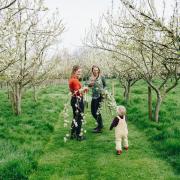When she’s not driving tractors or wielding a chainsaw, Cat Hadler is forging a deep connection with the landscape she manages
Cat Hadler isn't what most people would expect when meeting a National Trust area ranger for the first time. For a start, she doesn't have a beard and is rather a long way off retirement age. When it comes to wielding a chainsaw though, Cat is every bit as capable as she is at conducting ecological surveys. It's this can-do approach over the last six and a half years managing the National Trust's sites at Stockbridge Down and Stockbridge Common Marsh, which have led to her careful preservation of these stunning Hampshire locations and wildlife habitats.
When Cat left university with a degree in physical geography, she was keen to widen her skills and began volunteering at the trust's Leith Hill. Enrolling at Merrist Wood College, she focused on countryside management and honed her conservation expertise in her first job as a National Trust employee at Speckled Wood in Surrey where she helped build a roundwood timber-framed building.
"I learned how to drive a tractor, manage a flock of sheep, use a chainsaw and learned about different habitats and how to manage them. When I started in my role here, I was 26. I suppose I wasn't what the public expected from a ranger," she laughs. "However, times are changing. There are a lot more female rangers and arboriculturists. We're not unusual anymore and they've got used to me here."
From the more physical elements of the job to working alongside volunteers, the role of ranger is a diverse one and Cat relishes getting stuck into whatever the sites she manages require from season to season.
"My day or year can vary from ecological surveys to forestry felling, tractor driving, sheep management - I think they manage me more than I manage them," she says. "Then there's co-ordinating volunteers, engaging with the public, applying for grants, social media and lots of bigger projects like our riverbank fencing. I've always found it impossible to sum up as I don't just do one thing."
The beauty of such a unique role in caring for these landscapes is that she gets to see the difference she is making first-hand.
"For me, it's being able to see the impact that I'm having. I've seen my sites improve in condition in the time that I've been here, based on the works and consistency I've implemented. Every season I look forward to the return of things. It's so rewarding."
Maintaining a balance between habitat wildness and visitors engaging and enjoying the spaces without impacting too heavily on the ecosystems of these beautiful sites is paramount. However, it does pose certain challenges, as Cat explains.
"The time has come and gone that we can just let some habitats in southern England work on their own. If we hadn't intervened at the Marsh, there would have been no riverbank margin and it would have continued to erode. We wouldn't have any nesting birds at all as a result of dog and people pressure. If we don't take steps to preserve and try to improve the habitats in such a densely populated area of the country, then they don't stand a chance."
Cat sees her role as one of helping to educate. It's about encouraging others to play their part so that sites such as Stockbridge Down and the Marsh can be enjoyed for many more years to come.
"We hear good news stories about this population or that species doing well but, overall, our wildlife is not doing so well," she says. "I can see what's happening just on my site and while it may not save the nationwide trend of wildlife decline, I can do my bit to protect this little corner. It's our duty to keep managing them as so many species depend on them."
Part of the joy of Cat's job is the chance to get closer to nature and connect with the landscape around her. When the National Trust was set up in 1895, one of Octavia Hill's founding principles was to offer a chance for those in Victorian England's industrial cities to explore and enjoy green spaces, as an escape from the stress of their working lives. Continuing the trust's historical connection to the benefits offered by green spaces, it is sites such as these which still offer a much-needed opportunity to switch off from the hustle and bustle of modern life.
"I never know how to put it into words," Cat tries to explain. "It's a place where I can leave everything at the gate - all the humdrum, any confrontation, all the rubbish bits or just simply a busy day. I come here and everything's buzzing and humming. There are wild flowers of every colour. Time stops for a bit. I'll go up there and an hour might feel like a day. It's a place where you can go, put everything else on hold and take a breath."
As Cat describes the rich tapestry of landscape where the seasons blend seamlessly into each other, her passion for conservation and enthusiasm is catching. Not only does Stockbridge Down offer spectacular views across to Danebury Fort rising up in the distance, but its abundance of wildlife makes it one of Hampshire's most treasured sites. From the very high percentages of native butterfly species, including rare colonies of Duke of Burgundy butterflies, to skylarks and red kites soaring above the ancient Iron Age history beneath our feet, it's not hard to see how Cat has fallen in love with this tranquil spot. This is a wildlife oasis of chalk downland surrounded by farmland, where a flock of rare breed Wiltshire Horn sheep and commoners' cattle graze the land as in times past.
"It's a place of ancient memory, where we can leave the modern world behind and drift among the scrub-lined paths and flowery glades and simply exist without having to be anything," she says. "A place to witness the turn of the seasons, see the solstices come and go and really immerse ourselves in the turning of the wheel, taking ourselves back to our ancient roots, back to nature, back to the beginning."
Summer holds many highlights for Cat on the Down as it explodes with colour and offers the chance to hear the purring call of the turtle dove, a glimmer of luminescent glow-worms and the heady scent of wild herbs hidden in its glades.
"You can just amble around and see what it has to show you. It's a busy world and we're always on our phones or looking for something or have a deadline or a particular focus. Here is a place where you can go and not have any of that, yet still see and experience so much."
Climbing up the Down and gazing out across a sea of arable, it's the perfect antidote to a phrenetic day. Cat is right. It echoes Octavia Hill's lasting legacy to offer others 'a need of quiet, the need of air and the sight of sky'.
You can follow Cat's day to day working life on Instagram @swhantsnt. Visit the trust's website to find out more about wildlife walks and exploring Stockbridge Down: nationaltrust.org.uk.
More…
- 8 areas of Hampshire woodland to enjoy a walk or cycle - Our woodlands are a magical place to visit whatever the season. From the beauty of Micheldever Wood to Alice Holt Forest, we pay a visit to some of the best



























